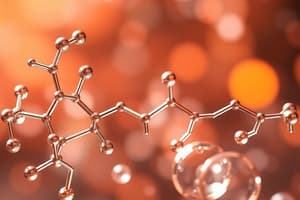Podcast
Questions and Answers
What is the role of stoichiometry in a chemical reaction?
What is the role of stoichiometry in a chemical reaction?
- Dealing with quantitative relationships between reactants and products (correct)
- Determining the speed of the reaction
- Creating new substances in a reaction
- Changing the state of matter in a reaction
Why is it essential to balance a chemical equation?
Why is it essential to balance a chemical equation?
- To speed up the reaction
- To ensure the conservation of mass and correct ratios of reactants to products (correct)
- To create more products
- To reduce the mass of the reactants
Which principle states that during any chemical reaction, mass is neither created nor destroyed?
Which principle states that during any chemical reaction, mass is neither created nor destroyed?
- Avogadro's Law
- Law of Conservation of Mass (correct)
- Dalton's Law
- Law of Multiple Proportions
In a balanced chemical equation, why is it important for both sides to have an equal number of atoms of each element?
In a balanced chemical equation, why is it important for both sides to have an equal number of atoms of each element?
What is the significance of understanding basic components like carbon and water in chemistry?
What is the significance of understanding basic components like carbon and water in chemistry?
How do chemists use the Law of Conservation of Mass in their work?
How do chemists use the Law of Conservation of Mass in their work?
What is the unique aspect of carbon that allows it to form molecules of varying shapes and sizes?
What is the unique aspect of carbon that allows it to form molecules of varying shapes and sizes?
Why is water considered a good solvent for ionic compounds?
Why is water considered a good solvent for ionic compounds?
Which of the following statements about carbon is true?
Which of the following statements about carbon is true?
What structural property of water allows it to form a hexagonal crystalline lattice structure?
What structural property of water allows it to form a hexagonal crystalline lattice structure?
In chemistry, what is the main role of water as a transport medium within cells?
In chemistry, what is the main role of water as a transport medium within cells?
Why is balancing discussed as a fundamental area within chemistry?
Why is balancing discussed as a fundamental area within chemistry?
Study Notes
Understanding Chemistry: A Primer on Essential Substances and Reactions
Chemistry is the study of matter, its composition, structure, properties, behavior, and changes that occur when different types of matter interact with one another. At the heart of this discipline lie several key elements and processes that form the basis of our understanding of the world around us. In this primer, we'll explore four fundamental areas within chemistry: carbon, water, chemical reactions, and balancing.
Carbon and Its Importance
Carbon is a crucial element found abundantly in nature, forming the backbone of many organic compounds. It is unique because it can bond with itself through single, double, and triple covalent bonds, which allows it to create molecules of varying shapes and sizes. This versatility makes carbon the building block of life; most living organisms are made up almost entirely of compounds containing carbon atoms.
The Nature of Water
Water is another central substance in chemistry. As a polar compound, it forms strong hydrogen bonds in liquid state, making it a good solvent for ionic compounds due to its ability to dissolve salts. Moreover, water has important structural properties because its molecules have bent geometry, allowing them to form a hexagonal crystalline lattice structure. Water also acts as a transport medium for nutrients and waste products within cells.
Chemical Reactions and Their Balancing Act
When two or more substances undergo change to produce a different type of matter, they are engaged in a chemical reaction. These reactions follow specific rules that help chemists understand how materials will react together. One such rule is Law of Conservation of Mass, stating that during any chemical reaction, mass is neither created nor destroyed. Another rule is stoichiometry, which deals with quantitative relationships between reactants and products in a balanced equation.
Balancing chemical equations involves ensuring each side of the equation contains the same number of atoms of each element. For example, if you were writing out the combustion of methane gas, CH₄ + O₂ → CO₂ + H₂O, both sides would need to contain equal numbers of C, H, and O atoms. This balance helps maintain conservation of mass and demonstrate the correct ratios of reactantsto product.
In summary, the foundation of chemistry lies in understanding basic components like carbon and water, learning about their essential properties, and exploring how these elements participate in various chemical reactions. By studying these principles, scientists can better comprehend the complex interactions happening all around us in nature.
Studying That Suits You
Use AI to generate personalized quizzes and flashcards to suit your learning preferences.
Description
Explore the basics of chemistry by delving into the properties and significance of carbon, water, chemical reactions, and balancing equations. Learn about the unique bonding capabilities of carbon, the structural properties of water, and the principles behind balancing chemical equations to maintain mass conservation.




